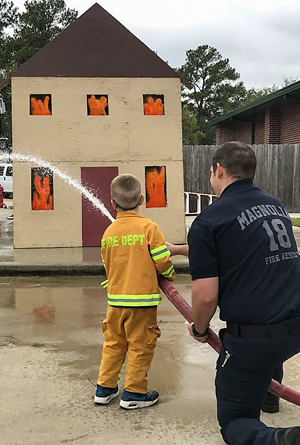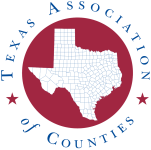County Magazine | February 13, 2023
Volunteer Fire Departments


Communities across the United States have historically relied on volunteer firefighters to offer fire protection when they need it. Even today, the number of volunteer firefighters outnumbers paid firefighters 3 to 1, but those numbers are changing.
There are nearly 20% fewer volunteer firefighters today than during the mid-1980s, when the National Volunteer Fire Council started keeping track of the data. During that time, calls for firefighting and EMS service have tripled. Today, more than a third of the volunteers are over the age of 50.
Texas has more than 1,500 fire departments that are mostly staffed by volunteers, but that number is slowly declining.
Firefighters used to simply sign up to be a volunteer, but now they have to finish hundreds of hours of training, which they typically complete while working a regular job. Volunteers often have to respond to EMS calls, which requires a different certification.
Historically, departments relied almost entirely on events — barbecues, fish frys, burger nights — to buy equipment, saving taxpayers billions of dollars, but as communities grow, so does the need for fire protection services.
It’s no wonder that many communities, particularly those on the quickly growing urban outskirts, have voted to create taxpayer-funded departments to improve response times.

During the fall, a handful of new volunteer firefighters graduated from the State Firefighters’ and Fire Marshals’ Association
(SFFMA) Fire Academy. These volunteers will work, often alongside paid firefighters, at departments across the state.
(Credit: Magnolia Fire Department)
Keeping up with growth
For more than 70 years, the town of Magnolia relied on an all-volunteer fire department that raised money for trucks, pumps and other gear through community dances, concession stands, turkey dinners and barbecues. In 2016, the volunteer department merged with the newly formed Montgomery County Emergency Services District (ESD) No. 10, a taxpayer-funded agency that now has 75 paid firefighters who call for help from the volunteer firefighters most nights of the week.
“I have been doing this since the pancake breakfast days, the sock hops, the dances,” said Magnolia Fire Chief Jeff Hevey, who has been in fire protection for 48 years. “That was the way of getting money.”
But as communities grow, departments have to grow to keep up with them, and that means they turn to different sources of funding. “As the departments grow as the community grows and an ESD or a city takes over that department, things change,” he said.
Hevey said that his district spans from the urban areas on the east, near The Woodlands, to a mostly rural section in the west. Those residents have different needs, and so do the firefighters who feel called to be part of the volunteer force.
Montgomery County ESD
No. 10 Board President Larry Smith said that keeping volunteers at the stations is about more than saving money.
“The Magnolia Fire Department has the old volunteer, small-town feel that we want to keep,” Smith said. “When you pool these resources, you pool different perspectives. They share their ideas and different perspectives. That gives us the opportunity to change and run more effectively.”
These days, volunteers are often asked to stay at the station during their shift so they can leave at the same time as the trucks and other emergency personnel. Because they are no longer at home and waiting around for a call, many districts pay those volunteers a stipend to be on call at the station.
Volunteer firefighting is a way that many people test out the field before pursuing it as a career. A quarter of recent hires at ESD No. 10 were from the volunteer force.


in Decemberto meet members of their community.
(Credit: Magnolia Fire Department)


fish fry every May that draws hundreds in Blanco County.
(Credit: Johnson City VFD)
“Our county is growing very fast; it’s hard to keep up,” Smith said. “We’ll need four or five more stations in the coming years. That’s more trucks, more staff.”
And more volunteers. In 2015, the National Volunteer Fire Council launched an initiative called Make Me A Firefighter to bring in new volunteer firefighters and EMS workers across the United States.
Fish frys, raffles and auctions
The switch to an ESD typically means that some of the volunteer-only departments close. In Smith County, 11 volunteer departments once served the rural areas around Tyler, but in 2007, they moved toward an ESD model and now there are paid firefighters at just five stations, but they are staffed 24 hours a day, seven days a week.
The Webb County Fire Department has recently invested in 10 new front-line units — four tankers, four fire pumpers and an ambulance per unit — over the next seven years to cover communities including Bruni, Mirando City, Oilton and Aguilares. Commissioners also approved 55 breathing masks for their firefighter volunteers.
But in counties that can’t invest that kind of money in their volunteer departments, many smaller departments continue to host fundraisers, raffles and auctions to raise money to supplement their budgets.
In Grayson County, the Locust Community Volunteer Fire Department in Pottsboro hosts a fish fry each year at a marina on Lake Texoma. Last year’s event included a silent auction for a four-wheeler and a guided pig hunt. The department receives 10% of its annual operating budget from Grayson County, and the fish fry is the biggest source of fundraising, according to the department’s board president, David Carson.
Volunteers with the North Hood County Volunteer Fire Department hand out candy at Halloween and raffled off a pellet barbecue smoker to help cover the increased costs they faced during brushfire season.
And each May, they host a fish fry. Chief Mike Bell said those fish frys aren’t going anywhere. The next one is already scheduled.
Fire departments also help one another in other ways. A rural department in Madison County needed an engine, but with a budget of $12,000 a year, it wasn’t going to be able to afford a new (or used) truck any time soon. So the Magnolia Fire Department/Montgomery County ESD No. 10 donated a used truck.
“We put $30,000 in repairs into that engine before we gave it to them,” Hevey said.
Hevey started his firefighting career as a volunteer. Even after he took on a full-time firefighting job, he continued to volunteer with a smaller department, a practice that is still common today.
“That’s just part of the culture,” he said.

